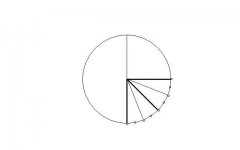Dividing the object ball into 1/8 ball increments for aiming gives us 5 distinct aiming points on the object ball to aim the center of the cue ball to cover, at most, the first 27 degrees (from straight in to half ball.) The half ball aim, which is 30 degrees, when comparing it to a straight shot on the same object ball in the same position, is only 27 degrees away from the straight in shot. The reason for this is that the angles compress in comparison to one another when the CB and OB positions don't change. Only the ghost ball moves. In this case, a 4/8 (half ball) aim is about 27 degrees away from 8/8 (full ball) aim.
And the angles further compress as the CB and OB get closer to one another. For example, a 6" distance between CB and OB yields a more compressed array of available angles than a 36" array.
What I wanted to show here is just how many shots are covered by 1/8 ball fractions. Obviously, the further the OB gets from the pocket, the more spread out the 1/8 ball shots become. I'm not suggesting that adjustments are not neccessary, but I am suggesting that very little adjustment is necessary when the OB is within about 3 diamonds from the pocket.
And when the CB is close to the OB, a different kind of adjustment is necessary. Since the angles are more compressed, you have to aim further away from center for successive cuts. An example of this phenomenon is the often undercut below-the-rack straight pool break shot. The CB and OB are often very close to one another, and the seemingly benign angle requires a steeper aim than feels comfortable.
Here are two pages showing 1/8 ball shots from the same object ball and cueball positions. The shots are all on the 15-ball to spots numbered by the 1-9 balls. The second page shows how even from 3 diamonds away from the rail, there are only subtle adjustments needed on the 1/8 ball aims to pocket all shots within the first 49 degrees. Imagine 4.5" pockets behind the 1-9 balls and how much space is covered by these 1/8 ball increments.
The 7-ball marks the 7th aiming point and 45 degrees away from straight in. That shows, at least to me, that fractional aiming can be very useful, since half of all angles and most of all shots we actually need to make are covered by the first 7 aims. And these aims are easy to find either on the OB or just off of it.
And the angles further compress as the CB and OB get closer to one another. For example, a 6" distance between CB and OB yields a more compressed array of available angles than a 36" array.
What I wanted to show here is just how many shots are covered by 1/8 ball fractions. Obviously, the further the OB gets from the pocket, the more spread out the 1/8 ball shots become. I'm not suggesting that adjustments are not neccessary, but I am suggesting that very little adjustment is necessary when the OB is within about 3 diamonds from the pocket.
And when the CB is close to the OB, a different kind of adjustment is necessary. Since the angles are more compressed, you have to aim further away from center for successive cuts. An example of this phenomenon is the often undercut below-the-rack straight pool break shot. The CB and OB are often very close to one another, and the seemingly benign angle requires a steeper aim than feels comfortable.
Here are two pages showing 1/8 ball shots from the same object ball and cueball positions. The shots are all on the 15-ball to spots numbered by the 1-9 balls. The second page shows how even from 3 diamonds away from the rail, there are only subtle adjustments needed on the 1/8 ball aims to pocket all shots within the first 49 degrees. Imagine 4.5" pockets behind the 1-9 balls and how much space is covered by these 1/8 ball increments.
The 7-ball marks the 7th aiming point and 45 degrees away from straight in. That shows, at least to me, that fractional aiming can be very useful, since half of all angles and most of all shots we actually need to make are covered by the first 7 aims. And these aims are easy to find either on the OB or just off of it.

